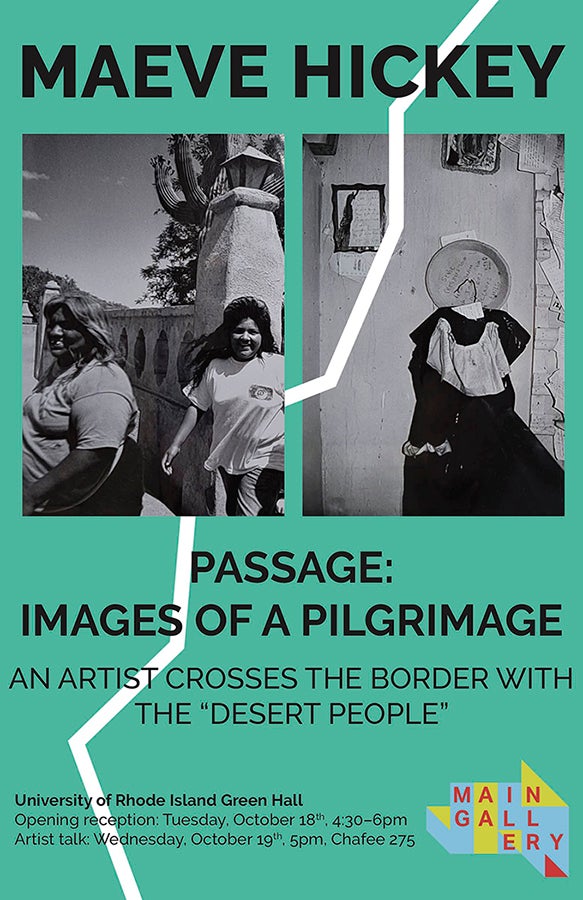KINGSTON, R.I. – Oct. 13, 2022 – In fall of 2018, artist and photographer Maeve Hickey made a five-day pilgrimage with members of the Tohono O’odham Nation in Arizona to the shrine of San Francisco Xavier in Magdalena de Kino, Sonora, Mexico.
The journey is the subject of a photo exhibit, “Passage: Images of a Pilgrimage – An Artist Crosses the Border with the ‘Desert People,’” being held in Green Hall on the University of Rhode Island’s Kingston Campus. The exhibit is free and open to the URI community and public. Green Hall, 35 Campus Avenue, is open from 8:30 a.m. to 4:30 p.m. The exhibit will be up through the end of the school year.
An opening reception with Hickey, a 1970 graduate of URI, was held Tuesday, Oct. 18, and Hickey, who is based in Ireland, visited campus from Oct. 17-20, discussing the exhibit in a talk in the Chafee Social Science Center and visiting classes and meeting with students while on campus. The exhibit and Hickey’s visit are hosted by the URI Department of Art and Art History and sponsored by the College of Arts and Sciences.
“This is my first exhibition at URI since I participated in student exhibitions,” said Hickey. “So, this is kind of a wonderful homecoming for me.”
Rebecca Levitan, director of the Main Gallery in the Fine Arts Center, is curating the exhibit of about 27 black and white photographs that line the walls of the first-floor hallway in Green Hall.
“This is really an interesting project that Maeve has been doing,” she said. “She’s done a number of series along the U.S.-Mexico border, but these photographs, where she’s documented this pilgrimage, are especially thought provoking.”
Hickey’s work spans numerous media – such as photography, sculpture, assemblages, and installations – and arises from profound engagement with place and people, especially along the U.S.-Mexico border, and in Ireland. Her work has been exhibited and represented in collections throughout Europe and the Americas, and she has been a visiting artist and fellow at numerous institutions. The Green Hall exhibit is her 25th solo exhibit.
In collaboration with anthropologist Lawrence Taylor, she has also published four books of photographs – “The Road to Mexico,” “The Tunnel Kids,” “Ambos Nogales,” and “Tales of the Desert Borderlands.”
In 2018, she accompanied about 100 members of the Tohono O’odham Nation, starting in Arizona in late September and walking beside them through the day’s heat and sleeping alongside them under the stars through the cold nights. The annual pilgrimage arrives at the shrine of San Francisco Xavier (also known as Saint Francis), an important saint to Mexicans in the region and to the Yaqui, Seri and Mayo tribes, by Oct. 4, St. Francis’ Day.
“I have photographed pilgrimages extensively in Europe and I have an artistic as well as personal interest in pilgrimage,” said Hickey. “I think that ultimately, the photographs in this exhibition tell an almost hidden story of life on the border. It is unusual because the journey crossed the border into Mexico, not out of Mexico, as is the usual route, and in a region that is so often seen as violent, lawless, and problematic, the pilgrimage represents deep humanity, faith, and hope.”
“The thing that makes the exhibit powerful for me is that it doesn’t seem to be trying to force one point of view,” said Levitan, an assistant teaching professor in painting and two-dimensional design. “It’s really very focused on small intimate moments, everyday people, and what life is like on this journey. It allows you to draw your own conclusions.”
The exhibit, Levitan said, fulfills several of her goals as director of the Main Gallery. It exposes art students to a different art form. Its subject challenges students and other viewers and isn’t artwork they might normally encounter. And, it helps show the career progression of an artist.
“When she was here, Maeve mostly studied painting,” she said. “But a lot of the work she’s done since then has been photography – showing the different ways of what you think of as your art can morph.”
Lastly, Levitan said the exhibit also shows art students – who are also liberal arts students – how to bring their interests into their art. “I think this work shows the interdisciplinary ways of thinking that is really a strength of the University of Rhode Island.”

